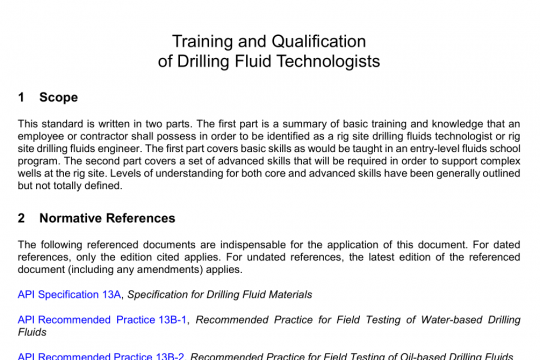API MPMS 8.4 pdf free download
API MPMS 8.4 pdf free download.Manual of Petroleum Measurement Standards Chapter 8.4 Standard Practice for Sampling and Handling of Fuels for Volatility Measurement.
5. Significance and Use 5.1 The vapor pressure parameters of volatile motor fuels are regulated by federal and state air pollution control agencies. In order to meet the letter of these regulations, it is necessary to sample, handle, and test these products in the precise manner as prescribed in this practice. 6. General Comments 6.1 Sample Containers: 6.1.1 Sample containers are clear or brown glass bottles, fluorinated high-density polyethylene bottles, or metal cans. The clear glass bottle is advantageous because it is easily examined visually for cleanliness, and also makes visual inspection of the sample for free water or solid impurities possible. The brown glass bottle affords some protection from light. The only seamed cans acceptable are those with the seams soldered on the exterior surface. 6.1.2 Screw caps of plastic or metal shall be used for all glass bottles. The caps for glass and metal containers shall have a seal to provide a vapor-tight closure. Inverted cone polyseals, polytetrafluoroethylene (PTFE)-faced media, or other materials that will not be affected by petroleum products shall be used as seals. Ifused, cork seals shall be ofgood quality, be clean, have an intact sealing surface that is faced with tin or aluminum foil, and be free from holes and loose bits of cork. The fluorinated bottles are supplied with polypropylene screw caps. Regardless of the bottle or can type, the screw cap shall be selected to ensure the sample integrity for the duration ofthe sample retain period.6.1.3 Sample size is dictated by the test method to be performed. One litre (32 oz) bottles or cans are generally used for manual vapor pressure testing. Some vapor pressure meth- ods may allow a smaller sample size to be taken, such as in a 125 mL (4 oz) bottle. See Fig. 1. 6.1.4 All sample containers shall be absolutely clean and free of foreign matter. Before reusing a container, wash it with strong soap solution, rinse it thoroughly with tap water, and finally with distilled water. Dry completely and stopper, or cap, the container immediately. 6.2 Sampling Apparatus—Sampling apparatus is described in detail under each ofthe specific sampling procedures. Clean, dry, and free all sampling apparatus from any substance that might contaminate the material. If necessary, use the cleaning procedure described in 6.4. 6.3 Time and Place ofSampling: 6.3.1 Storage Tanks—When loading or discharging fuels, take samples from both shipping and receiving tanks, and from the pipelines if required. 6.3.2 Ship or Barge Tanks—Sample each product after the vessel is loaded or just before unloading.6.4.4 Rinse or flush sample containers with product and allow it to drain before drawing the sample. A rinse is performed to pre-load the sample container with vapors when the temperature of the sample and the sample container are equal. A flush is performed to bring the temperature of the sample container to that of the sample, which in turn pre-loads the container with vapors ofthe material. Ifthe sample is to be transferred to another container (for testing other than DVPE), the sampling apparatus also is rinsed with some of the product and drained. When the sample is emptied into this container, upend the sampling apparatus into the opening of the sample container. 6.5 Handling Samples: 6.5.1 Protect all samples of light fuels from evaporation. The sampling apparatus is the sample container for vapor pressure. Keep the container tightly closed after the sample is collected. Leaking sample containers are not suitable for testing. Cool volatile samples to 0 °C to 1 °C (32 °F to 34 °F) after delivery to the laboratory and before opening the con- tainer. Maintain at this temperature throughout transfer and handling, if at all possible. 6.5.2 Never completely fill a sample container. Fill the container to 70 % to 85 % capacity to allow adequate room for expansion. Subsequent testing for vapor pressure requires this level of container fill. API MPMS 8.4 pdf download.




